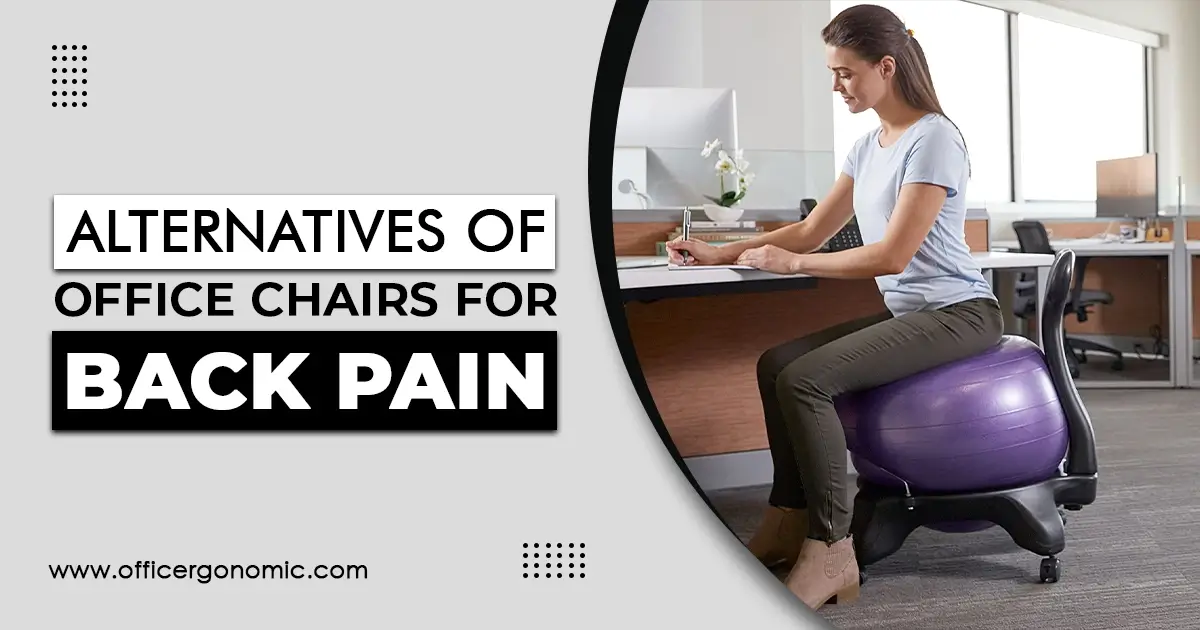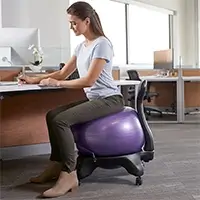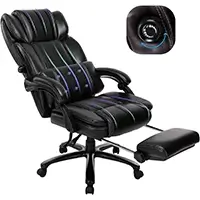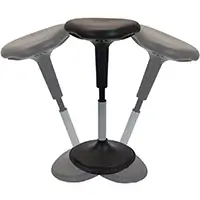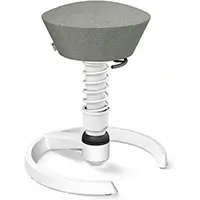Office Chair Alternatives for Back Pain
We all know that sitting in conventional office chairs for prolonged periods is detrimental to our bodies because it makes our muscles stiff and weak in the long run. Sitting workstations put office workers at risk of developing back pain and other musculoskeletal problems.
Some of the most common health issues include sciatica, spinal stenosis, herniated disc, and degenerative disc disease or osteoarthritis. Fortunately, there’s a solution to this problem. You can choose different office chair alternatives for back pain and improve your overall health. In this article, we’ll be discussing some of the best office chair alternatives for back pain, so keep reading!
Office Chair Alternatives For Back Pain
Dynamic or active seating is becoming increasingly popular. Any seating that engages different muscles of your body and gives you the margin to make small movements during your sitting time is considered active seating. This type of sitting really helps keep your back muscles active and prevent pain.
Ergonomic chairs with good lumbar support are considered a perfect fit for those at risk of back pain. Even if the support isn’t enough, a lumbar support pillow can easily fill the gap. However, other than ergonomic office chairs or simple desk chairs, there are plenty of options that you can explore to prevent back pain.
Here, we provide a few replacements for a conservative office chair with tips for choosing the right one. We will also list the pros and cons of each alternative to assist you further.
1. Standing Desks
A standing desk is an excellent substitute for standard office chairs. Standing promotes movement, which is necessary for maintaining a good posture and avoiding muscle stiffness. The best part about a standing desk is that it has an ergonomically positioned laptop stand, which makes it easier for the user to work while standing.
It’s crucial to take two things into account when choosing the right standing desk. The desk should be at a height that allows your arms to form a 90-degree angle while typing. Additionally, pay attention to your posture by keeping your shoulders loose and your feet hip-width apart.
Fixed-height workstations are exclusively for standing whereas a stand-up desk converter lets you alternate between sitting and standing as per your choice. The preferred option is the latter one, but it can cause you foot pain if you don’t wear comfortable shoes.
Pros Cons Relieves pressure from muscles and assists to maintain proper posture Maximizes the use of muscles hence strengthening them. Fixed-height standing desks don’t give a choice to sit Excessive standing may damage joints.
2. Balance Ball chairs
Also known as a stability or exercise ball chair, a balance ball is another alternative to traditional office chairs. These ball chairs promote active sitting while keeping your spine in a neutral position and taking off pressure from your lower back.
Sitting on a balance ball chair engages your core muscles, which helps to strengthen your back and abdominal muscles. Constant movement is required to maintain the body’s balance and also helps to improve blood circulation and reduce stiffness in your muscles.
While choosing a balance ball, make sure it is the right size for your height. You can check this by placing your feet flat on the ground and your knees at a 90-degree angle. Maintain your pose by sitting with your back straight and your shoulders relaxed.
Pros Cons Strengthens the core and leg muscles Improves the circulation of blood. Prolonged use of a balance ball can cause back pain resulting in slouching and poor posture. A person sitting in a balance ball may fail to balance for a long time due to uneven support.
3. Treadmill Desks
If you want to gain the health benefits associated with physical exercise while working, a treadmill desk is an excellent option. These desks feature a built-in treadmill that allows you to walk or jog while you work. In this way, you can stay active for a long time.
Walking improves blood circulation, burns calories, and reduces stress. These benefits make the treadmill desk an excellent choice for back pain patients. A treadmill desk with adjustable height can ensure a perfect ergonomic position for your body.
When selecting a treadmill desk, consider the size of the desk and the treadmill. Make sure the desk can accommodate your work items, and the length of the treadmill is enough for comfortable walking.
Pros Cons Improves the circulation of blood and cardiac health. Helps to burn calories due to more physical activity. A treadmill desk takes up a lot of physical space in your workstation. Formal and workout attires are a point of contradiction while using a treadmill desk.
4. Saddle Chairs
Sitting for a long time in an office chair can take a toll on the body, especially the back. You must choose the right office chair to maintain good posture. Saddle chairs are designed to promote a healthy sitting pose.
Saddle chairs have a unique shape that forces the body to open up the hips, with the knees positioned lower and tilting the pelvis forward. This results in the natural alignment of your spine and helps mitigate back pain.
When choosing a saddle chair, go for one with an adjustable height and tilt. Height and tilt adjustability will allow you to take the load off your spine and maintain an upright position. Also, make sure that your saddle chair has a comfortable seat.
Pros Cons A saddle chair corrects posture. Lowers tightness in the back, neck, and other body parts. If not adjustable, a saddle chair is usually too high for standard office desks. Increased chances of slipping off the chair due to the absence of a backrest.
5. Kneeling Chairs
A kneeling chair is one of the best alternatives to any conventional office chair. Kneeling chairs help you sit upright by distributing your body weight equally, strengthening your back muscles, and aligning your hips and spine. The declining seat of the kneeling chairs tilts the pelvis forward with an angle of 110° or between 120° and 130°.
When choosing a kneeling chair, it’s necessary to consider the angle and distance between the seat and knee pads and the balancing ability of the chair. An adjustable kneeling chair works best as it allows the users to find a position that suits them the most. Also, maintain a proper pose, sitting with a straight back and relaxed shoulders.
Pros Cons Assists in spine alignment and good posture. Improves blood circulation and strengthens core muscles. Compresses the shins and causes pain in the front legs. Restricts leg movements.
6. Bean Bag Chairs
Another comfortable and relaxed alternative to traditional office chairs is bean bag chairs. They are designed to provide support and comfort while sitting. These chairs can help ease pressure on the lower back by promoting a more natural pose that aligns the spine.
A large bean bag will offer ergonomic support that reduces stress in your shoulders, hips, gluteal muscles, and sciatic nerves. They can conform to the user’s body and you naturally stay in a supported pose.
When looking for a bean bag chair, consider these tips: the material should be soft and cushiest, the size of the bean bag chair should easily accommodate your body and its shape should maintain proper spinal alignment.
Pros Cons Improves your back health. It is a comfortable and inexpensive alternative to a traditional office chair. A bean bag chair is hard to get up from because of its softness It is not sturdy and needs to be refilled with time.
7. Recliner Chairs
A reclining office chair is another option for those looking for an office chair alternative for back pain. These chairs allow you to sit in a comfortable reclined position, which can help to reduce pressure on your lower back.
Recliner chairs also provide excellent lumbar support. Also, if their head and back are adjustable, they can easily fit your body type and posture. They provide enough room for changing your sitting position according to your comfort.
Make sure you choose the right recliner chair according to your height and size. You can also add additional features to your recliner chairs e.g. more cushioning and adjustable height. Moreover, it may have a swivel base, armrests, and head and neck pillows.
Pros | Cons |
|
|
8. Wobble Chairs
A wobble chair has a rounded base with a pivot point, providing 360° of rotation that allows movement in all directions while sitting. As you can achieve all combinations of exercise motion, it helps strengthen the core muscles and lessen the strain on the back.
The strength and mobility of your spinal disc, ligament, and tendon are enhanced using a wobble chair, thus helping to promote better posture. Also, it plays a role in the lubrication of spinal joints and the nourishment of their cartilage.
When choosing a wobble chair, look for an adjustable height and a sturdy base. Also, make sure the chair has a comfortable seat and backrest. The wobble chairs are safe for bearing weights up to 300 pounds.
Pros Cons Always keep your muscles slightly stretched, reducing back aches It is a better option for your eyes as you don't have to lean and squint constantly to focus on different things. May take some time to get used to it due to a lack of back support and armrests It does not serve as a remedy for pre-existing back pain, but it may help to prevent it
9. Swopper Chair
A swopper chair is an ergonomic stool that provides a healthy sitting position. It improves your sitting pose because of the absence of a backrest. It keeps the ligaments and joints fit
and prevents back pain due to micro-movements of the body in all directions with its 3D technology.
A swopper stool assists in conditioning your core muscles, releasing neck stiffness, and improving circulation without leaving your seat as you sway slightly in all directions. Also, its minimal design makes it stylish and easy to carry or move if needed.
To select the right swopper stool/chair for you, make sure that the swopper stool is height adjustable. The height adjusts through a lever below the seat. Also, the seat should be wide enough so that it may not put stress on your hips.
Pros Cons 3D technology that allows constant movement (right, left, upward, downward, back and forth) and lowers the back ache The width and convex design of the swopper stool seat makes it comfy to sit for extended periods A good quality swopper chair may be costly as its price ranges somewhat between $600 to $800 Some users may find the seat a little firm and need a cushion
Final Thoughts!
In short, it’s essential to keep your preferences such as your type of work, body size and type, and health conditions (if any) in mind so you can choose better among the alternatives for your office chair. What’s better is that you experiment with different options by sitting on them and testing them from every aspect rather than rushing into making the final decision.
If you consult with a healthcare professional before going on the hunt, you’ll be in a better position to choose an option that best suits your bodily needs. By selecting a suitable alternative office seating for your needs, you may improve your posture, relieve pressure on your spine, and feel comfortable during your working hours.

